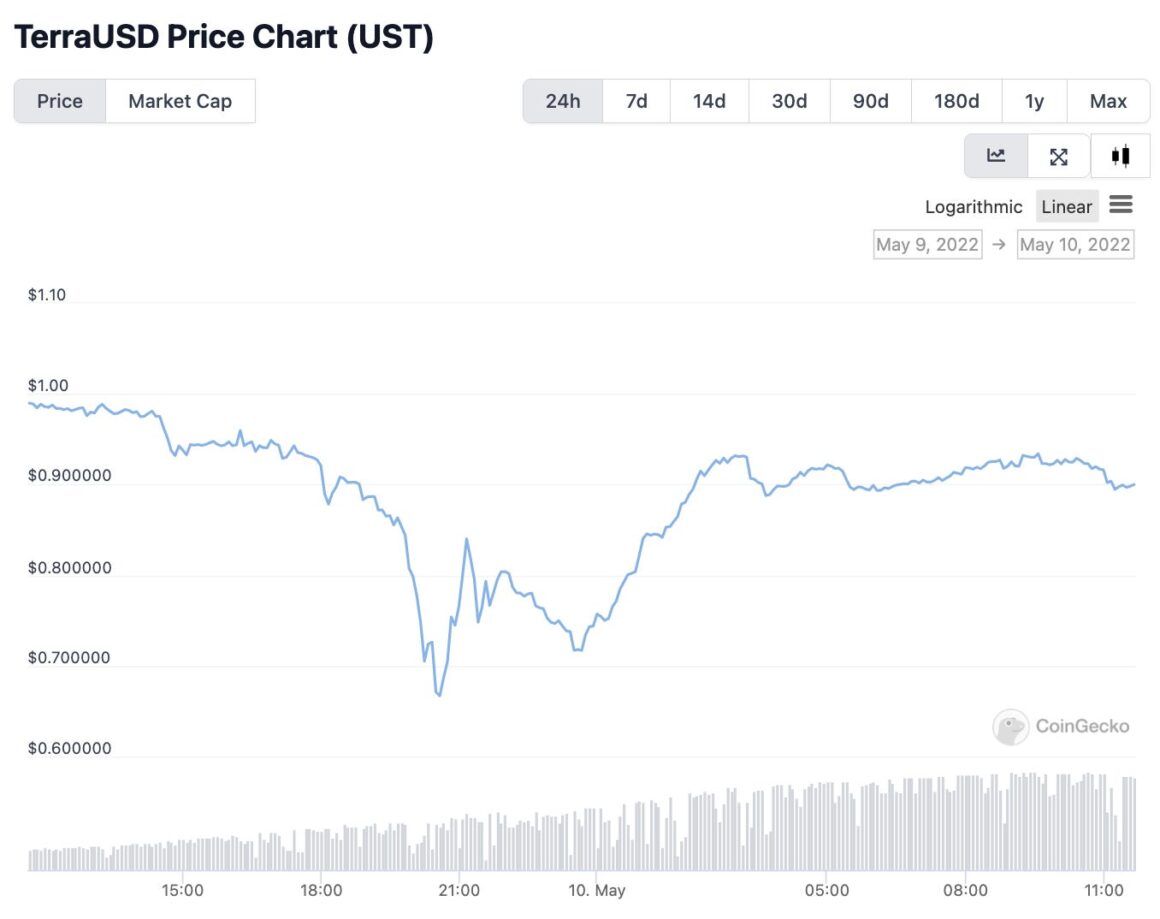CoinGecko
- TerraUSD fell below its $1 peg in a weekend selloff.
- The fall of the token and its sister coin luna put the spotlight on algorithmic stablecoins.
- The value of such cryptocurrencies are set by a computer algorithm.
The recent plunge of the TerraUSD cryptocurrency below its peg to the US dollar is highlighting vulnerabilities in so-called algorithmic stablecoins, two experts told Insider on Tuesday.
TerraUSD is the fourth-largest stablecoin in the cryptocurrency market, according to CoinMarketCap. Heavy selling in TerraUSD — or UST — that started over the weekend prompted it to lose its $1 peg twice, with the Monday's move taking it as low as $0.67, according to CoinGecko data. UST's price is maintained by its sister coin called luna, which itself on Tuesday fell by 41%. UST traded at around $0.90 on Tuesday.
"The problem with an algorithmic stablecoin is there's no formula that can currently predict everything that's going to happen, and to my knowledge, there isn't a very successful Artificial Intelligence algorithm that self-adjusts," said Mark Fidelman, direct of SmartBlocks, an agency that develops marketing strategies for cryptocurrency technology and businesses. He's also the host of the "Cryptonized" podcast on YouTube.
The value of algorithmic stablecoins is set by a computer algorithm. Those digital assets are unlike so-called traditional stablecoins which are backed up by fiat currency and hard assets such as government bonds or gold.
There's a balancing act in UST. If it drops below $1, traders can take them out of circulation by "burning" them in exchange for $1 of luna. If UST climbs above $1, traders sell luna to convert into UST, pushing its price down.
Crypto observers over the weekend reportedly witnessed large withdrawals of UST from Anchor Protocol, which acts as a bank for the token. One big holder dumped $285 million worth of the token, crypto news site CoinTelegraph reported.
The Luna Foundation Guard, a non-profit aimed at growing the terra ecosystem and that oversees that UST holds its peg to the dollar, deployed $1.5 billion in capital to allay market concerns around UST. UST, however, de-pegged for a second time and luna slid in value.
The foundation said Monday it loaned $750 million worth of bitcoin to trading firms to help protect the UST peg and loaned 750 million in UST to accumulate bitcoin as market conditions normalized.
The Luna Foundation's reserves as of Tuesday stood at $195 million, a drop of 83% from the previous day, according to a breakdown of its reserves the foundation makes available on its Twitter page. The reserves were made of the Avalanche token, the luna token and UST itself.
"When pressure was put on it and the underlying assets associated with it started to decline and the reserves couldn't fill that staking, then the peg breaks," Adam Carlton, chief executive of PinkPanda Holdings, told Insider. PinkPanda provides consulting services on digital assets and is building a mobile app for users to access cryptocurrencies, NFTs and the metaverse.
The UST and luna price drops came after a rough week for US equities as investors continued to price in expectations for the Federal Reserve to aggressively raise interest rates to cool down inflation that in March kicked up to a 41-year high. Cryptocurrencies including bitcoin also suffered losses alongside the broader equity market.
"Theoretically [holding the dollar peg] works when you don't have market volatility or you have reserves but what we saw with UST is it doesn't work when you have extreme market volatility, which we know is incredibly common in cryptocurrency," said Carlton.
Last week, LFG said it had bought $1.5 billion worth of bitcoin to add to its reserves. It has said in the past it intends to acquire $10 billion in bitcoin for its reserves.
"The problem is you're collateralizing now a cryptocurrency with yet another cryptocurrency. So there's just no tie into real-world assets," said Carlton. "Everyone has put US dollars into all these funds – they put it into bitcoin, they put it into UST, they put it into luna," said Carlton. "And then as people sell and withdraw back into fiat, then they all decline … so it's a very much a compounding effect."
There are some stablecoins that are "pretty predictable," enough so that institutions use them, said Fidelman.
"So if one of the pillars of that foundation breaks then it calls a lot of other things into the question. Cryptos are an emerging, new market and there needs to be more confidence in it for new people, new investors, new institutions to get involved in it," he said.
"Now, is it going to be devastating to crypto? Absolutely not. But you can see some of the impact – whether it's related to luna or not – that it's having on the overall crypto market," Fidelman said.
